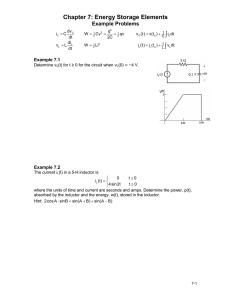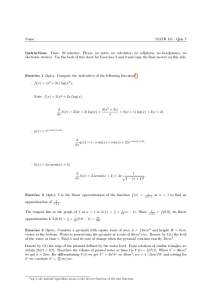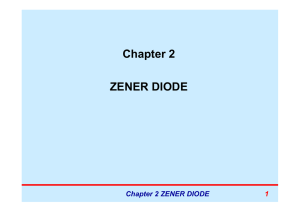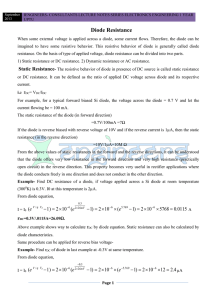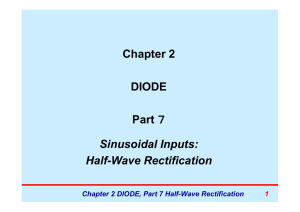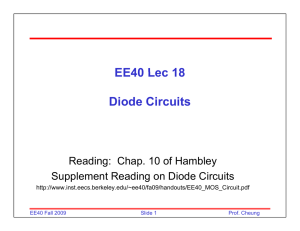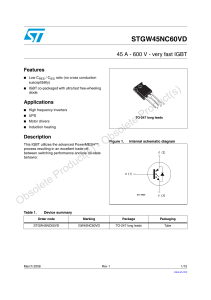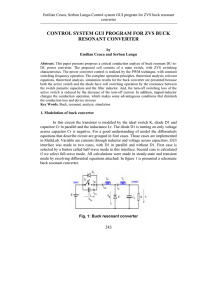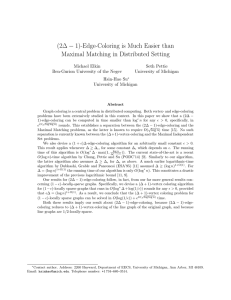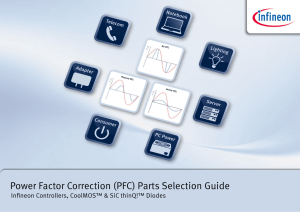PDF - MIT
advertisement
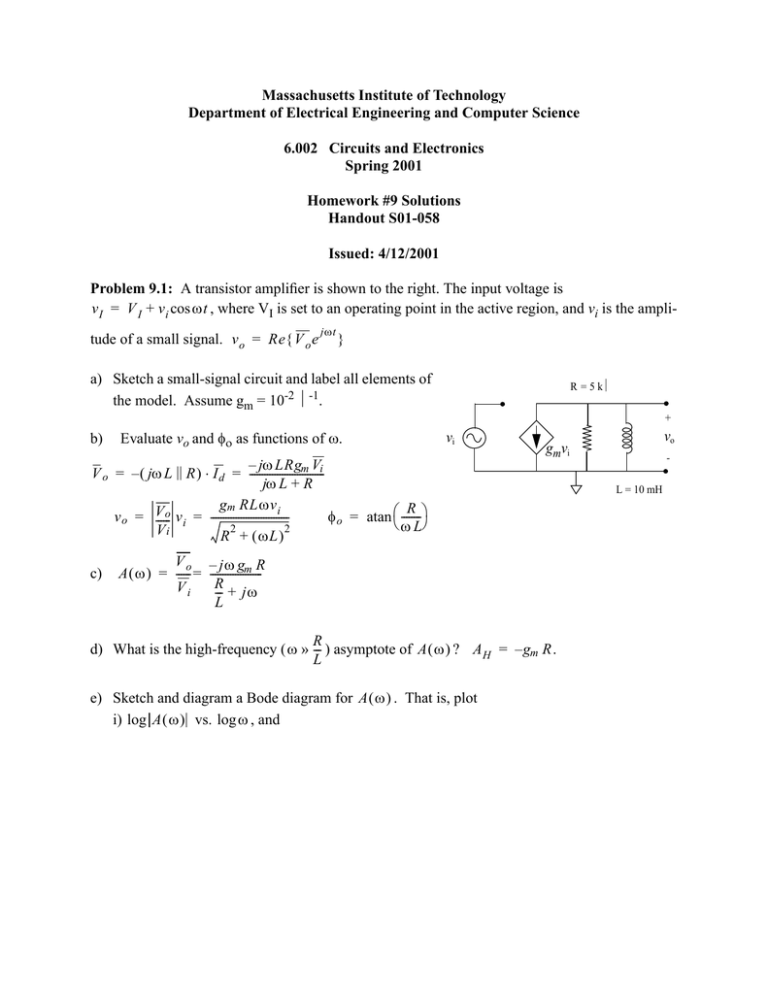
Massachusetts Institute of Technology
Department of Electrical Engineering and Computer Science
6.002 Circuits and Electronics
Spring 2001
Homework #9 Solutions
Handout S01-058
Issued: 4/12/2001
Problem 9.1: A transistor amplifier is shown to the right. The input voltage is
v I = V I + v i cos ωt , where VI is set to an operating point in the active region, and vi is the amplitude of a small signal. v o = Re { V o e
jωt
}
a) Sketch a small-signal circuit and label all elements of
the model. Assume gm = 10-2 Ω-1.
R = 5 kΩ
+
b)
Evaluate vo and φο as functions of ω.
vi
gm v i
– jω LRgm Vi
V o = – ( jω L || R ) ⋅ I d = ----------------------------jω L + R
gm RLωv i
R
φ o = atan --------
vo = V
-----o- v i = ------------------------------
ω
L
2
2
Vi
R + ( ωL )
c)
Vo
A ( ω ) = ------ =
Vi
– jω gm R
-------------------R
--- + jω
L
R
d) What is the high-frequency ( ω » --- ) asymptote of A ( ω ) ? A H = – gm R .
L
e) Sketch and diagram a Bode diagram for A ( ω ) . That is, plot
i) log A ( ω ) vs. log ω , and
vo
L = 10 mH
ii) ∠ A ( ω ) vs. log ω , where ∠ A ( ω ) denotes the phase angle of A ( ω ) .
Bode Diagrams
2
1.5
Phase (deg); Magnitude (Log)
1
0.5
0
−80
−100
−120
−140
−160
−180
4
10
5
6
10
7
10
10
Frequency (rad/sec)
Problem 9.2: A circuit which involves an ideal diode as
well as an inductor and capacitor is shown below. The
circuit is at rest for t < 0.
iL
L = 1 mH
+
Vu-1(t)
a) What are the values of iL(0+) and vc(0+)?
+
-
iL(0+) = 0 (initially the inductor is an open circuit)
vc
C = 10µF
-
vC(0+) = 0 (initially the capacitor is a closed circuit)
b) What is the state of the diode at t = 0+ (i.e., is it a short or an open)?
The voltage drops across the inductor, leaving the voltage across the diode zero. For the ideal
diode, this is the short, closed, forward-biased, or active state.
c) Write differential equations for iL(t) and vc(t) with the diode closed (i.e., active).
iL(t ) = iC(t )
1
d
--- ∫ v L = C v C
L
dt
∫ V – ∫ vC
V u –1 = v C + LC
V u –1
1
di
= v C + v L = ---- ∫ i + L
C
dt
d
dt
d
= LC v C
dt
2
v
2 C
2
CV u 0 = i + LC
di
dt
2
d) Determine iL(t) and vc(t).
We’ll solve vc(t) and then use the constituent relationship to find iC(t) = iL(t).
General solution with homogenous solution and particular integral:
vc ( t ) = K 1 e
–s1 t
+ K 2e
–s2 t
+V
1
Characteristic equation: LCs2+1 = 0 gives s 1, s 2 = ± j ------- = ± jω o
LC
From initial conditions:
vC(t=0) = 0 = K1 + K2 + V
d
i ( t ) = C v C = – Cs 1 K 1 – Cs 2 K 2 = 0
dt
Solution:
– jt
------------
gives K1 = -V/2 and K2 = -V/2
jt
------------
V LC V LC
v c ( t ) = V – ---- e
– ---- e
= V – V cos ( ω o t )
2
2
i ( t ) = VCω o sin ( ω o t )
e) Find the time t1 at which the diode opens.
The ideal diode can not have a negative current, but i(t) goes both positive and negative in the
equation above. In this case, the ideal diode allows the current to pass to the capacitor but
stops the inductor from pulling the current back. The first time the current i(t) goes from posiπ
tive to negative is when ω o t = π ∴t 1 = -----ωo
f) What are the values of iL(t) and vc(t) for t > t1?
After t1, i(t) = 0 and vC(t) = 2V.
Problem 9.3: The circuits below are driven by sinusoids and are in the sinusoidal steady-state.
V
In each case determine the complex input impedance Z ( s ) = -----i and the indicated voltage transIi
V
fer ratio A ( s ) = -----o- . Express each function as a ratio of polynomials in s.
Vi
V i = Z ( s )I i
1
sRC + 1
Z a ( s ) = R + ------ = -------------------sC
sC
a)
V
R
s
A a = -----o- = ----------------- = ----------------1
1
Vi
R + -----s + -------sC
RC
sR 1 R 2 C + R 1 + R 2
1
Z b ( s ) = R 2 || ------ + R 1 = -------------------------------------------sC
sR 2 C + 1
b)
1
R 2 || -----R2
sC
A b ( s ) = ------------------------------- = -------------------------------------------1
sR
R
C
+
R
+
R
1
2
1
2
R 2 || ------ + R 1
sC
2
s R1 R2 C 1 C 2 + s ( R1 C 1 + R2 C 1 + R2 C 2 ) + 1
1
1
Z c ( s ) = R 2 || --------- + R 1 + --------- = ---------------------------------------------------------------------------------------------------------2
sC 2
sC 1
s R C C + sC
1
c)
1
1
2
1
R 2 || --------sC 2
sR 2 C 1
- = ---------------------------------------------------------------------------------------------------------A c ( s ) = -----------------------------------------------2
1
1
s
R
R
C
C
+
s
(
R
C
+
R
C
+
R
C
)
+
1
R 2 || --------- + R 1 + --------1 2 1 2
1 1
2 1
2 2
sC 2
sC 1
Problem 9.4: For each of the transfer functions shown below, sketch and dimension Bode diagrams showing log A and ∠ A vs. log ω . In each case, s = jω.
a)
Bode Diagrams for 9.4a
2
1.5
Phase (deg); Magnitude (log)
1
0.5
0
100
80
60
40
20
0
0
10
1
2
10
10
Frequency (rad/sec)
3
10
Bode Diagrams for 9.4b
−2.5
Phase (deg); Magnitude (log)
−3
−3.5
−4
0
−20
−40
−60
−80
−100
4
10
5
6
10
10
Frequency (rad/sec)
Bode Diagrams for 9.4c
−2.5
Phase (deg); Magnitude (log)
−3
−3.5
−4
100
50
0
−50
−100
0
10
1
10
2
10
3
10
Frequency (rad/sec)
4
10
5
10
6
10

